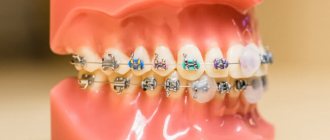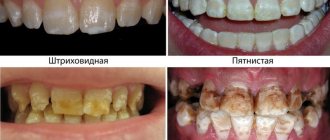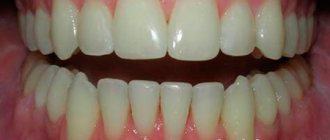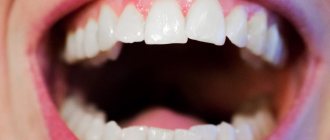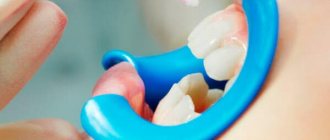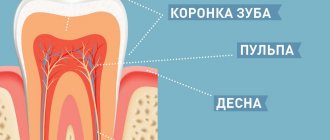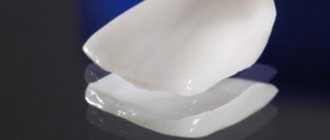Features of the period.
During this period, the formation and further development of the roots of baby teeth occurs: they are strengthened in the bone tissue of the jaws. The processes of root formation smoothly flow into the processes of their resorption and replacement with permanent teeth, the rudiments of which are located under the milk teeth.
The presence of interdental spaces between the incisors and canines of the upper and lower jaws is a sign of a “normal” correctly developing occlusion of primary teeth. The absence of interdental spaces in the primary dentition indirectly indicates a lack of space for the eruption of permanent incisors and canines, the crowns of which are significantly wider.
PHOTO: Teeth of a 3-year-old child. By the age of 3, a child already has a full set of teeth in his mouth. There should be spaces between baby teeth.
Starting from 5-6 years of age, the bite of temporary (baby) teeth is replaced with permanent ones. This is preceded by the growth of the rudiments of permanent teeth and the physiological resorption of the roots of milk teeth. As the roots of baby teeth are reabsorbed, mobility of these teeth appears. At this age, parents often note mobility of the lower and upper front teeth (deciduous incisors). When the root is completely absorbed, the tooth may fall out on its own: sometimes children “help” the tooth fall out with their tongue, constantly rocking it. Sometimes the “loss” of a resorbed tooth occurs while eating or playing.
Closer to 6 years, the first permanent chewing tooth (first molar) erupts behind the last milk tooth. The eruption of the first permanent molar is not accompanied by the loss of any tooth and does not cause any discomfort to the child, so it often goes unnoticed.
Parents often take the first permanent chewing tooth for additional milk, as it bursts behind all the milk teeth and this does not precede the loss of the milk tooth: it seems that the child has 24 malate tooth.
PHOTO: Milk teeth in children aged 6 years. The lower lateral incisors fell out. Soon permanent lateral incisors will appear in their place.
How to help your child while teething?
Teething is a very difficult period for babies and parents. The baby is constantly tormented by itching, less often short-term pain, and other unpleasant symptoms. It is worth remembering that there are no 100% sure ways that will help alleviate the baby’s condition. Each baby is individual, and therefore it is necessary to approach this issue individually. Parents need to try different methods and observe the reaction.
Teething in a child most often begins at about six months of age; at this age, the introduction of complementary foods generally begins. Quite often, children refuse complementary feeding and demand their mother's breast. Thanks to this, babies receive not only the necessary nutrition, but also “painkillers”, “sedatives”, etc., which significantly alleviates the child’s condition. It is not recommended to insist on introducing complementary foods, otherwise you can simply provoke vomiting.
Dentists advise giving your child teethers, which can be different. The best characteristics are provided by teethers with fillings that must be pre-cooled. Cold can reduce itching and pain, and “scratching” the gums with a teether promotes faster teething.
You can massage the gums with a gauze pad previously soaked in cold water. Such actions simultaneously relieve itching in the toddler’s gums and clean the oral cavity. Before starting the procedure, parents' hands should be thoroughly washed. The massage should be neat, gentle, with the complete exclusion of pressing and sudden movements.
In order to reduce signs of inflammation, you can wipe your baby’s mouth with solutions of medicinal plants, such as chamomile decoction. You can use the decoction in various ways, give the kids to drink it, or gently wipe the mouth with it, make applications - applying for a while a gauze swab, generously soaked in the decoction.
In pharmacies and widely sold, there are many specialized gels for teething, which contain an anesthetic substance, in most cases it is lidocaine. Before using the gel, you must read the product label. The drug must be used according to strict instructions and in no case more often. Otherwise, it could end badly.
The mechanism of action of such drugs is based on superficial anesthesia (numbness) of the mucous membrane, due to which all unpleasant sensations are reduced and the baby can eat or fall asleep peacefully.
Typical problems.
The most typical problem between the ages of 3 and 6 years is the development of caries of primary teeth in the area of the first and second primary molars. The narrow interdental spaces between the first and second primary molars, which are difficult for a child to reach, are an ideal place for plaque to accumulate. As a result, caries forms on the surface of the teeth hidden from the eyes of parents (between the 4th and 5th milk teeth). Being unnoticed, the carious process quickly progresses, complicated by inflammation of the nerve of the tooth (pulpitis).
With poor oral hygiene and a large number of carious teeth, caries of the permanent molar (6th tooth) often develops, high-quality treatment of which is only possible by a pediatric dentist.
What problems might there be?
The most common problem that parents of 3-year-old children often face is tooth decay. It quickly affects baby teeth, causing destruction of enamel, especially if the child does not clean the oral cavity thoroughly enough and eats a lot of sweets. The first signs of caries often go unnoticed because they appear as white spots, and the teeth of children with such enamel lesions do not hurt.
If you do not take your child to the dentist regularly, they quickly progress to deeper stages, first affecting the enamel, and then the deeper tissues with the development of pulpitis or periodontitis. Such complications are manifested by pain, redness of the gums, fever and other unpleasant symptoms. They require immediate intervention by a dentist and often lead to the removal of the diseased tooth.
Other dental problems at 3 years of age include:
- Yellow plaque on teeth. It often appears due to poor oral hygiene or staining of plaque with pigments from food.
- Black plaque on teeth. Its appearance can be provoked by various factors, for example, dysbiosis in the baby, the development of pigment-forming microorganisms in the baby’s oral cavity, or taking iron supplements.
- Underdevelopment of tooth enamel, which is manifested by darkening of the enamel, white spots and increased fragility of the teeth.
- Excess fluoride in the water consumed by a child, due to which the teeth become covered with white stripes, as well as white or brown spots, and erosion occurs on the surface of the teeth.
- Crooked teeth. This problem is more common after the molars erupt, but baby teeth can also grow crooked, for example, if the child sucks his thumb or is not eating well.
Read also: Temperature during teething of molars in children
Why do teeth take a long time to appear?
A delay in their appearance for a period of up to 6 months is normal. All children are different, and the timing of the appearance of teeth is individual for each. However, if the baby is already over a year old, parents begin to worry about the question of why the child’s teeth are not growing for a long time.
They may appear late in children with general growth retardation as a result of a disease, for example, rickets. In this case, you should consult a doctor - maybe the child lacks some vitamins.
Sometimes the long growth of teeth depends on intrauterine development, on the mother’s nutrition during pregnancy and breastfeeding. Teeth growth slows down when there is a lack of certain minerals and vitamins in the body, especially calcium. The cause of slow growth can be various infections and diseases. Even illnesses of the mother during pregnancy can also be a cause.
Young parents always look forward to the appearance of their baby's first teeth. But sometimes the coveted white bump on the gum does not form for a very long time, and this begins to worry parents. The question arises: why does the child’s teeth not grow? Delay in the eruption of some teeth can occur not only in the first years of a baby’s life, but also later, at an older age. This article will help you figure out what could be the reasons for the delay in the appearance of teeth and what to do about it.
Why don't teeth grow after baby teeth fall out?
Delayed eruption can be observed both in babies who are waiting for their first bite, and at an older age when it changes. Parents need to know when they should not worry and when they should see a doctor because their child’s teeth are not growing for a long time.
The process of eruption of milk units, and then their replacement by adults, is a complex phenomenon that has not yet been fully studied by specialists. Various opinions and hypotheses, with the help of which they try to identify the causes of pathology, are not always confirmed scientifically. In addition, the growth of hard tissues in children is also associated with the individual maturation of the body, which is different for each person.
If we are talking about the first units, then they should appear before 17 months, and a year behind the norm in the case of a change from a milk bite to a permanent one also indicates pathology and some deviations. But before judging the delay in eruption, the doctor must make sure that the germ itself is embedded in the child’s bone tissue. Otherwise, we are talking about adentia, that is, the complete or partial absence of dental units.
We suggest you familiarize yourself with wisdom tooth caries: what to do – treat or remove
The very delay in their appearance is most often associated with the following disorders:
- heredity, genetic predisposition - if this process began late in the parents, then, most likely, this pattern will continue in the younger generation;
- premature baby, too low fetal weight, congenital anomalies;
- illnesses of the mother during pregnancy - after all, the rudiments of the milk bite are formed already in the first trimester, which only a few future parents know about;
- any pathological processes or infections in the baby’s body in the first months of life - at this time doctors try to supplement the child’s diet with vitamin complexes so that the little body has enough strength to fight pathogenic bacteria and form teeth at the same time;
- trauma during childbirth;
- mechanical damage to the child’s jawbone (impacts, fractures, causing the rudiment to be driven into the gum or periosteum, which prevents its correct appearance);
- lack of rational, balanced and nutritious nutrition, insufficient amounts of calcium, vitamin D and other mineral components;
- if caries has damaged the milk units too much, affecting the rudiments of the permanent ones - therefore it is important to treat them at any age and follow strict prevention;
- serious diseases - Down syndrome, rickets, panhypopituitarism, etc.
These reasons often affect not only the timely eruption of teeth, but also their general condition, health, usefulness of enamel and dentin, susceptibility to diseases, etc. Therefore, it is so important for parents to periodically examine the child’s oral cavity. Thus, you can notice the beginning of a change in bite, its sequence, diseases at the initial stage, and other pathologies. For any deviations, it is advisable to consult a dentist and follow his recommendations.
In attempts to determine the norms and timing of correct bite formation in childhood, doctors identify the following main important factors:
- Gender of the baby - it has been noticed that girls develop teeth earlier than boys.
- Height - short children are characterized by slower teething.
- On the lower jaw, dentin forms faster than on the upper jaw.
- Location – molars are more likely to experience growth retardation compared to incisors.
- Condition of occlusion - milk units appear earlier and more and more often doctors note their accelerated and premature development. But permanent teeth may be slightly behind schedule.
- Country of residence and race - Europeans are more likely to suffer from late teething.
- Climate, air temperature - the hotter it is, the faster teeth appear in children.
- Socio-economic factors influence the state of health and diet, as a result of which various deviations are observed in the case of a lack of material resources to ensure good living conditions.
- Urbanization – it has also been noted that children’s teeth grow faster in the city than in the countryside.
- Birth order - in large families, a phenomenon is noticed that younger sisters and brothers suffer from stunted growth of milk and permanent units much more often.
Causes of delayed loss of baby teeth
Sometimes the situation develops the other way around: the tooth is long overdue to fall out, but it continues to stay, albeit poorly, in the same place. Delayed loss of temporary units can have serious consequences, such as the formation of “shark teeth”, crooked dentition and the appearance of malocclusion.
The reasons for the delay in loss may be:
- Genetics. The buds of new teeth may grow slowly due to the physiology or genetic predisposition (heredity) of the child.
- Edentia. This term refers to the complete absence of radical units in humans. It is known that the rudiments of temporary and molar incisors, canines, premolars and molars are laid in the jaws during the period of intrauterine development of the fetus. If a pregnant woman led an unhealthy lifestyle, suffered from infectious diseases or had other health problems during pregnancy, this could cause edentia.
We suggest you read about: Gum pain after wisdom tooth removal: how long will the consequences last?
